Potrebujeme váš súhlas na využitie jednotlivých dát, aby sa vám okrem iného mohli ukazovať informácie týkajúce sa vašich záujmov. Súhlas udelíte kliknutím na tlačidlo „OK“.
ASTM E2122-02(2013)
Standard Guide for Conducting In-situ Field Bioassays With Caged Bivalves (Withdrawn 2022)
Automaticky preložený názov:
Štandardné príručka pre dirigovanie v mieste polí biotesty, S v klietke lastúrnikov
NORMA vydaná dňa 1.3.2013
Informácie o norme:
Označenie normy: ASTM E2122-02(2013)
Poznámka: NEPLATNÁ
Dátum vydania normy: 1.3.2013
Kód tovaru: NS-44377
Počet strán: 30
Približná hmotnosť: 90 g (0.20 libier)
Krajina: Americká technická norma
Kategória: Technické normy ASTM
Kategórie - podobné normy:
Anotácia textu normy ASTM E2122-02(2013) :
Keywords:
bioaccumulation, bivalve, exposure effects, field bioassay, growth, in-situ, ICS Number Code 13.060.70 (Examination of water for biological properties)
Doplňujúce informácie
| Significance and Use | |||||||
|
5.1 The ecological importance of bivalves, their wide geographic distribution, ease of handling in the laboratory and the field, and their ability to filter and ingest large volumes of water and sediment particles make them appropriate species for conducting field bioassays to assess bioaccumulation potential and associated biological effects. The test procedures in this guide are intended to provide guidance for conducting controlled experiments with caged bivalves under “natural,” site-specific conditions. It is important to acknowledge that a number of “natural” factors can affect bivalve growth and the accumulation of chemicals in their tissues (Section 5.2 The ultimate resources of concern are communities. However, it is often difficult or impossible to adequately assess the ecological fitness or condition of the community or identify and test the most sensitive species. Bivalves are recommended as a surrogate test species for other species and communities for the following reasons: (1) They readily accumulate many chemicals and show sublethal effects associated with exposure to those chemicals (2); (2) they accumulate many chemicals through multiple pathways of exposure, including water, sediment, and food Bivalve Species |
Species Compared |
Exposure |
End Point |
Sensitivity |
|||
|
Anodonta grandis daphnia, fathead minnow, rainbow trout |
municipal effluent |
LC-50 |
equal |
||||
|
Anodonata imbecilis daphnia |
pulp and paper |
10-d vs 7-d mortality |
more |
||||
|
Anodonata imbecilis
daphnia, midge, |
metals |
7-d mortality |
equal |
||||
|
Musculium transversum 17 diferent species |
ammonia |
20-d mortality |
more sensitive than |
||||
|
Mercenaria mercenaria 2 amphipods, microtox |
sediment |
7-d growth, 10-d mortality |
more |
||||
|
Caged Mercenaria more sensitive than lab Mercenaria Mullinia lateralis amphipod |
sediment |
7-d growth, 10-d mortality |
more |
||||
|
Mytilus
galloprovincialis (18) |
amphipod |
in-situ water column |
84-d growth, 10-d mortality |
more, [tissue TBT] |
|||
5.2.1 Chronic tests designed to monitor sublethal end points, such as growth, are recommended because bivalves generally show increasing sensitivity with increasing exposure period. Sublethal end points measured in bivalves that have demonstrated high levels of sensitivity include growth 5.2.2 There are many field monitoring programs in the US which use bivalves, including the NOAA Status and Trends Program (45), the California Mussel Watch 5.3 Bivalves are an abundant component of many soft bottom marine, estuarine, and freshwater environments. Intertidal marine bivalves make up a significant portion of many habitats and provide habitats for many additional species. It is important to monitor freshwater bivalves for the following reasons: they are among the first taxa to disappear from benthic communities impacted by chemicals; they have been shown to be more sensitive than several other major taxa in laboartory tests.5.4 If practical, the species to be used in a field bioassay should be one that is endemic to the area under investigation. In many cases, the specific area under investigation may not support bivalves due to a variety of factors including high concentrations of chemicals, competition or predation, or lack of suitable habitat or substrate. Under these conditions, it may be desirable to use a species that would normally be found in the environment if all conditions were favorable; however, it may be necessary to use a surrogate species, that is, a species that can tolerate the environmental conditions but is not normally found in the area, if native species are unavailable in the test area.
5.5 Bivalves generally utilize one of two primary modes of feeding: filter-feeding or deposit feeding. However, all known deposit-feeding bivalves are facultative in that they can either deposit- or filter-feed. Filter-feeders assimilate dissolved organics as well as suspended particulate matter, including plankton and suspended sediments, from the water column and have the potential for exposure to chemicals associated with this ingested material. Facultative deposit-feeding bivalves can be exposed to chemicals associated with sediments as they ingest sediments. They also ingest particulate material from the water column as they filter feed. As such, bivalves are capable of integrating exposure to chemicals dissolved in water and sorbed on sediment particles on the bottom or in suspension. It should be acknowledged that bivalves transplanted in the overlying water above sediment or transplanted directly on or in sediment may not exclusively accumulate or be affected by chemicals in a particular medium. That is, bivalves in or on sediment may still filter and accumulate chemicals from overlying water. Conversely, bivalves transplanted in the water column may filter suspended sediment and accumulate chemicals from that sediment. Bivalves can also assimilate chemicals as they ventilate overlying water.
5.6 Field bioassays are conducted to obtain information concerning the bioavailability of chemicals in the water column or bedded sediments and subsequent biological effects on bivalves after short- and long-term exposure to water and sediment under site-specific conditions. These bioassays do not necessarily provide information about whether delayed effects will occur, although a post-exposure observation period could provide such information. Sublethal post-exposure observations may include gonad development, spawning success, gamete survival, and development. The decision to conduct post-exposure studies in the field or in the laboratory depends on the observations being made, test conditions required, and experimental logistics.
5.7 The in-situ exposures described in this guide could be followed by laboratory measurements, such as scope for growth 5.8 The bivalve field bioassay can be used to determine the spatial or temporal trends of chemical bioavailability in water and sediment and effects due to exposure to those chemicals. Spatial comparisons of parameters of concern can be made by distributing the caged bivalves along physical and chemical gradients at scales commensurate with the desired level of discrimination. For example, station locations might be distributed along a known physical or chemical gradient in relation to the boundary of a disposal site 5.9 The relative bioavailability of chemicals from the various pathways of exposure (that is, aqueous phase, suspended particulate matter, sediment) and subsequent effects can be determined by simultaneously deploying bivalves with different feeding strategies and making supplementary measurements. A combination of filtration and the use of sediment traps followed by chemical analysis of the various environmental compartments can be used to identify the relative contribution of the aqueous phase, suspended particulate matter, and sediment. Lipid bags or semi-permeable membrane devices (SPMDs), which predominantly collect the dissolved fraction of chemicals, could also be used 5.10 Results of bivalve field bioassays might be an important consideration when assessing the hazards of materials to aquatic organisms (see Guide E1023) or when deriving water or sediment quality guidelines for aquatic organisms 1.1 This guide describes procedures for conducting controlled experiments with caged bivalves under field conditions. The purpose of this approach is to facilitate the simultaneous collection of field data to help characterize chemical exposure and associated biological effects in the same organism under environmentally realistic conditions. This approach of characterizing exposure and effects is consistent with the US EPA ecological risk assessment paradigm. Bivalves are useful test organisms for in-situ field bioassays because they (1) concentrate and integrate chemicals in their tissues and have a more limited ability to metabolize most chemicals than other species, (1.2 The test is referred to as a field bioassay because it is conducted in the field and because it includes an element of relative chemical potency to satisfy the bioassay definition. Relative potency is established by comparing tissue concentrations with effects levels for various chemicals with toxicity and bioaccumulation end points (6, 7, 8, 9, 10) even though there may be more uncertainty associated with effects measurements in field studies. Various pathways of exposure can be evaluated because filter-feeding and deposit-feeding are the primary feeding strategies for bivalves. Filter-feeding bivalves may be best suited to evaluate the bioavailability and associated effects of chemicals in the water column (that is, dissolved and suspended particulates); deposit-feeding bivalves may be best suited to evaluate chemicals associated with sediments (11, 12). It may be difficult to demonstrate pathways of exposure under field conditions, particularly since filter-feeding bivalves can ingest suspended sediment and facultative deposit-feeding bivalves can switch between filter- and deposit feeding over relatively small temporal scales. Filter-feeding bivalves caged within 1 m of bottom sediment have also been used effectively in sediment assessments from depths of 10 to 650 m 1.3 These field testing procedures with caged bivalves are applicable to the environmental evaluation of water and sediment in marine, estuarine, and freshwater environments with almost any combination of chemicals, and methods are being developed to help interpret the environmental significance of accumulated chemicals (6, 7, 9, 16, 17). These procedures could be regarded as a guide to an exposure system to assess chemical bioavailability and toxicity under natural, site- specific conditions, where any clinical measurements are possible.
1.4 Tissue chemistry results from short- and long-term exposures can be reported in terms of concentrations of chemicals in bivalve tissues (for example, µg/g), amount (that is, weight or mass) of chemical per animal (for example, µg/animal), rate of uptake, or bioaccumulation factor (BAF, the ratio between the concentration of a chemical in bivalve tissues and the concentration in the external environment, including water, sediment, and food). Tissue chemistry results can only be used to calculate a BAF because caged bivalves in the field are exposed to multiple sources of chemicals and can accumulate chemicals from water, sediment, and food. Toxicity results can be reported in terms of survival 1.5 Other modifications of these procedures might be justified by special needs or circumstances. Although using appropriate procedures is more important than following prescribed procedures, results of tests conducted using unusual procedures are not likely to be comparable to results of standardized tests. Comparisons of results obtained using modified and unmodified versions of these procedures might provide useful information concerning new concepts and procedures for conducting field bioassays with bivalves.
1.6 This guide is arranged as follows:
|
|
Section |
|
|
|
|
Referenced Documents |
2 |
|
Terminology |
3 |
|
Summary of Guide |
4 |
|
Significance and Use |
5 |
|
Interferences |
6 |
|
Hazards |
7 |
|
Experimental Design |
8 |
|
Apparatus |
9 |
|
Facilities |
|
|
Construction Materials |
|
|
Cages |
|
|
Test Organisms |
10 |
|
Species |
|
|
Commonly Used Taxa |
|
|
Size and Age of Test Organisms |
|
|
Source |
|
|
Number of Specimens |
|
|
Collection |
|
|
Handling |
|
|
Holding |
|
|
Animal Quality |
|
|
Field Procedures |
11 |
|
Test Initiation: Presort |
|
|
Final Measurements and Distribution |
|
|
Attachment of PVC Frames |
|
|
Deployment |
|
|
Retrieval and End-of-Test Measurements |
|
|
Analysis of Tissues for Background Contamination |
|
|
Collection and Preparation of Tissues for Analysis |
|
|
Quality Assurance/Quality Control Procedures |
|
|
Sample Containers, Handling, and Preservation |
|
|
Ancillary Methodology |
12 |
|
Temperature |
|
|
Food |
|
|
Acceptability of Test |
13 |
|
Report |
14 |
|
Keywords |
15 |
|
References |
|
1.7 The values stated in SI units are to be regarded as standard. No other units of measurement are included in this standard.
1.8 This standard may involve hazardous materials, operations, and equipment – particularly during field operations in turbulent waters or extreme weather conditions. This standard does not purport to address all of the safety concerns, if any, associated with its use. It is the responsibility of the user of this standard to establish appropriate safety and health practices and determine the applicability of regulatory requirements prior to use. Specific hazard statements are given in Section 7.
|
Standard Guide for Conducting Acute Toxicity Tests on Aqueous Ambient Samples and Effluents with Fishes, Macroinvertebrates, and Amphibians |
|
|
Standard Guide for Conducting Bioconcentration Tests with Fishes and Saltwater Bivalve Mollusks |
|
|
Standard Terminology Relating to Biological Effects and Environmental Fate |
|
|
Standard Practice for Preservation by Freezing, Freeze-Drying, and Low Temperature Maintenance of Bacteria, Fungi, Protista, Viruses, Genetic Elements, and Animal and Plant Tissues |
|
|
Standard Test Method for Measuring the Toxicity of Sediment-Associated Contaminants with Estuarine and Marine Invertebrates |
|
|
Standard Guide for Collection, Storage, Characterization, and Manipulation of Sediments for Toxicological Testing and for Selection of Samplers Used to Collect Benthic Invertebrates |
|
|
Standard Guide for Designing Biological Tests with Sediments |
|
|
Standard Guide for Determination of the Bioaccumulation of Sediment-Associated Contaminants by Benthic Invertebrates |
|
|
Standard Test Method for Measuring the Toxicity of Sediment-Associated Contaminants with Freshwater Invertebrates |
|
|
Standard Practice for Statistical Analysis of Toxicity Tests Conducted Under ASTM Guidelines |
|
|
IEEE/SI 10 |
American National Standard for Use of the International System of Units (SI): The Modern Metric System |
|
Standard Guide for Assessing the Hazard of a Material to Aquatic Organisms and Their Uses |
|
|
Standard Terminology Relating to Water (Includes all amendments and changes 2/14/2024). |
|
|
Standard Practice for Preparation of Sediment Samples for Chemical Analysis |
|
|
Standard Guide for Disposal of Laboratory Chemicals and Samples |
|
|
Standard Guide for Conducting Static Short-Term Chronic Toxicity Tests Starting with Embryos of Four Species of Saltwater Bivalve Molluscs |
|
|
Standard Guide for Conducting Acute Toxicity Tests on Test Materials with Fishes, Macroinvertebrates, and Amphibians (Includes all amendments and changes 2/22/2023). |
|
|
Standard Guide for Conducting Life-Cycle Toxicity Tests with Saltwater Mysids (Includes all amendments and changes 1/27/2023). |


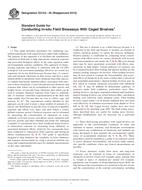
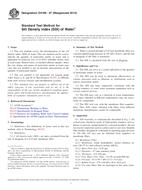 ASTM D4189-07(2014)..
ASTM D4189-07(2014)..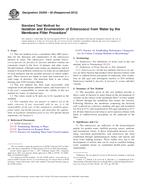 ASTM D5259-92(2012)..
ASTM D5259-92(2012)..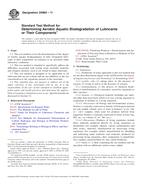 ASTM D5864-11
ASTM D5864-11 ASTM D6503-99(2009)..
ASTM D6503-99(2009)..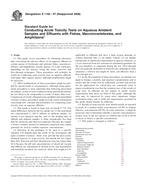 ASTM E1192-97(2008)..
ASTM E1192-97(2008)..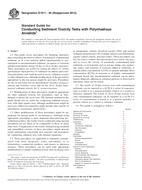 ASTM E1611-00(2013)..
ASTM E1611-00(2013)..
 Cookies
Cookies
